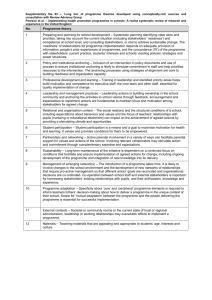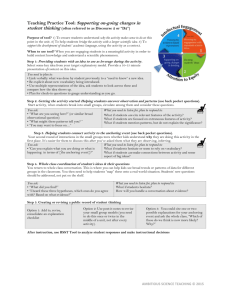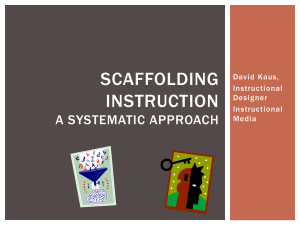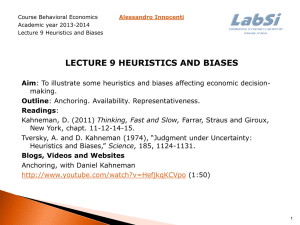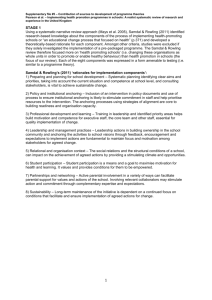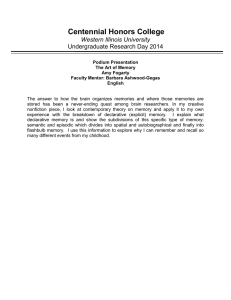AMR-09-0093-Original.R2 Chutes versus ladders: Anchoring events and a punctuated-equilibrium perspective on...
advertisement
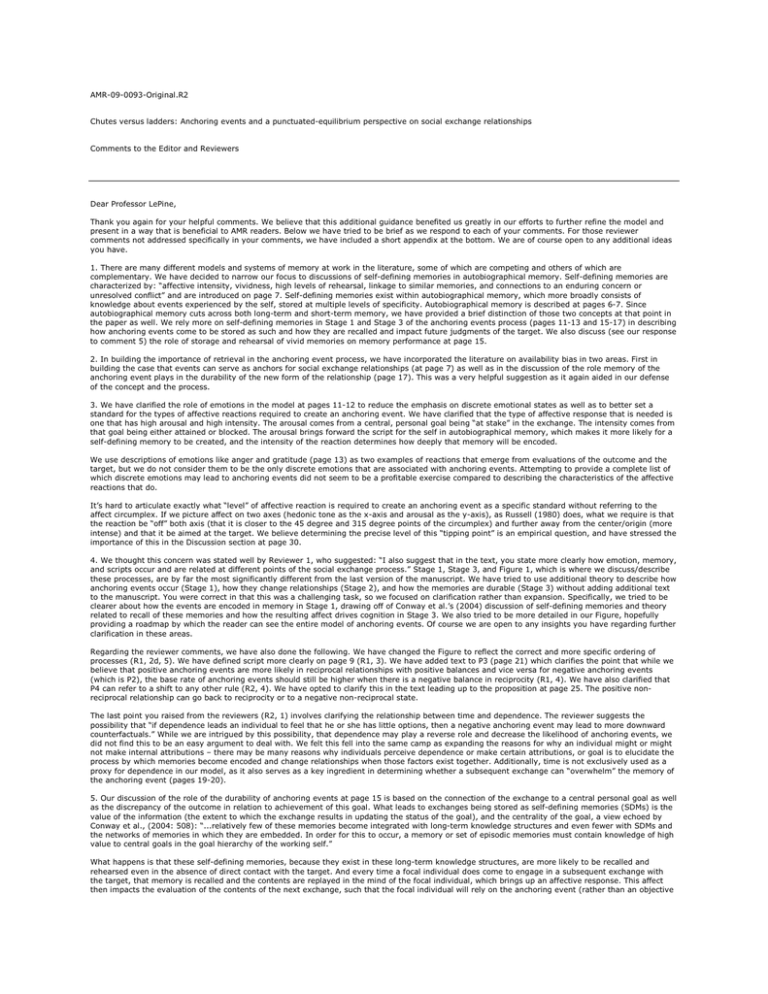
AMR-09-0093-Original.R2 Chutes versus ladders: Anchoring events and a punctuated-equilibrium perspective on social exchange relationships Comments to the Editor and Reviewers Dear Professor LePine, Thank you again for your helpful comments. We believe that this additional guidance benefited us greatly in our efforts to further refine the model and present in a way that is beneficial to AMR readers. Below we have tried to be brief as we respond to each of your comments. For those reviewer comments not addressed specifically in your comments, we have included a short appendix at the bottom. We are of course open to any additional ideas you have. 1. There are many different models and systems of memory at work in the literature, some of which are competing and others of which are complementary. We have decided to narrow our focus to discussions of self-defining memories in autobiographical memory. Self-defining memories are characterized by: “affective intensity, vividness, high levels of rehearsal, linkage to similar memories, and connections to an enduring concern or unresolved conflict” and are introduced on page 7. Self-defining memories exist within autobiographical memory, which more broadly consists of knowledge about events experienced by the self, stored at multiple levels of specificity. Autobiographical memory is described at pages 6-7. Since autobiographical memory cuts across both long-term and short-term memory, we have provided a brief distinction of those two concepts at that point in the paper as well. We rely more on self-defining memories in Stage 1 and Stage 3 of the anchoring events process (pages 11-13 and 15-17) in describing how anchoring events come to be stored as such and how they are recalled and impact future judgments of the target. We also discuss (see our response to comment 5) the role of storage and rehearsal of vivid memories on memory performance at page 15. 2. In building the importance of retrieval in the anchoring event process, we have incorporated the literature on availability bias in two areas. First in building the case that events can serve as anchors for social exchange relationships (at page 7) as well as in the discussion of the role memory of the anchoring event plays in the durability of the new form of the relationship (page 17). This was a very helpful suggestion as it again aided in our defense of the concept and the process. 3. We have clarified the role of emotions in the model at pages 11-12 to reduce the emphasis on discrete emotional states as well as to better set a standard for the types of affective reactions required to create an anchoring event. We have clarified that the type of affective response that is needed is one that has high arousal and high intensity. The arousal comes from a central, personal goal being “at stake” in the exchange. The intensity comes from that goal being either attained or blocked. The arousal brings forward the script for the self in autobiographical memory, which makes it more likely for a self-defining memory to be created, and the intensity of the reaction determines how deeply that memory will be encoded. We use descriptions of emotions like anger and gratitude (page 13) as two examples of reactions that emerge from evaluations of the outcome and the target, but we do not consider them to be the only discrete emotions that are associated with anchoring events. Attempting to provide a complete list of which discrete emotions may lead to anchoring events did not seem to be a profitable exercise compared to describing the characteristics of the affective reactions that do. It’s hard to articulate exactly what “level” of affective reaction is required to create an anchoring event as a specific standard without referring to the affect circumplex. If we picture affect on two axes (hedonic tone as the x-axis and arousal as the y-axis), as Russell (1980) does, what we require is that the reaction be “off” both axis (that it is closer to the 45 degree and 315 degree points of the circumplex) and further away from the center/origin (more intense) and that it be aimed at the target. We believe determining the precise level of this “tipping point” is an empirical question, and have stressed the importance of this in the Discussion section at page 30. 4. We thought this concern was stated well by Reviewer 1, who suggested: “I also suggest that in the text, you state more clearly how emotion, memory, and scripts occur and are related at different points of the social exchange process.” Stage 1, Stage 3, and Figure 1, which is where we discuss/describe these processes, are by far the most significantly different from the last version of the manuscript. We have tried to use additional theory to describe how anchoring events occur (Stage 1), how they change relationships (Stage 2), and how the memories are durable (Stage 3) without adding additional text to the manuscript. You were correct in that this was a challenging task, so we focused on clarification rather than expansion. Specifically, we tried to be clearer about how the events are encoded in memory in Stage 1, drawing off of Conway et al.’s (2004) discussion of self-defining memories and theory related to recall of these memories and how the resulting affect drives cognition in Stage 3. We also tried to be more detailed in our Figure, hopefully providing a roadmap by which the reader can see the entire model of anchoring events. Of course we are open to any insights you have regarding further clarification in these areas. Regarding the reviewer comments, we have also done the following. We have changed the Figure to reflect the correct and more specific ordering of processes (R1, 2d, 5). We have defined script more clearly on page 9 (R1, 3). We have added text to P3 (page 21) which clarifies the point that while we believe that positive anchoring events are more likely in reciprocal relationships with positive balances and vice versa for negative anchoring events (which is P2), the base rate of anchoring events should still be higher when there is a negative balance in reciprocity (R1, 4). We have also clarified that P4 can refer to a shift to any other rule (R2, 4). We have opted to clarify this in the text leading up to the proposition at page 25. The positive nonreciprocal relationship can go back to reciprocity or to a negative non-reciprocal state. The last point you raised from the reviewers (R2, 1) involves clarifying the relationship between time and dependence. The reviewer suggests the possibility that “if dependence leads an individual to feel that he or she has little options, then a negative anchoring event may lead to more downward counterfactuals.” While we are intrigued by this possibility, that dependence may play a reverse role and decrease the likelihood of anchoring events, we did not find this to be an easy argument to deal with. We felt this fell into the same camp as expanding the reasons for why an individual might or might not make internal attributions – there may be many reasons why individuals perceive dependence or make certain attributions, or goal is to elucidate the process by which memories become encoded and change relationships when those factors exist together. Additionally, time is not exclusively used as a proxy for dependence in our model, as it also serves as a key ingredient in determining whether a subsequent exchange can “overwhelm” the memory of the anchoring event (pages 19-20). 5. Our discussion of the role of the durability of anchoring events at page 15 is based on the connection of the exchange to a central personal goal as well as the discrepancy of the outcome in relation to achievement of this goal. What leads to exchanges being stored as self-defining memories (SDMs) is the value of the information (the extent to which the exchange results in updating the status of the goal), and the centrality of the goal, a view echoed by Conway et al., (2004: 508): “...relatively few of these memories become integrated with long-term knowledge structures and even fewer with SDMs and the networks of memories in which they are embedded. In order for this to occur, a memory or set of episodic memories must contain knowledge of high value to central goals in the goal hierarchy of the working self.” What happens is that these self-defining memories, because they exist in these long-term knowledge structures, are more likely to be recalled and rehearsed even in the absence of direct contact with the target. And every time a focal individual does come to engage in a subsequent exchange with the target, that memory is recalled and the contents are replayed in the mind of the focal individual, which brings up an affective response. This affect then impacts the evaluation of the contents of the next exchange, such that the focal individual will rely on the anchoring event (rather than an objective weighing of goods and services exchanged) to evaluate the target. Because of the structure of memory (page 15) and the availability heuristic (page 17), the overall result here is that there is a non-linear process at play: small and medium events are prone to being lost in response to changes in goal processing because they do not get encoded or recalled in the same way (as per Conway et al., 2004). But large events, if they are attributed internally and with controllability to the target, because they change our view of the self as well as our view of the other and they are continuously rehearsed in future exchanges, are stored more permanently and therefore affect that relationship for a long period of time. 6. We’ve addressed these at pages 32-33 with an eye towards providing managers with a proactive approach to cope with the risks surrounding negative anchoring events and to address the impact of anchoring events in the workplace so as to minimize their social impact, an approach recommended in Reviewer 3, comment 5. 7. Regarding Reviewer 1, comment 1e, we rely on models of self-defining memory and their relationships to interpersonal scripts, as well as models regarding the retention of specific items and events in long-term memory. We also rely on specific theories of retrieval like availability. With that said, we’ve eliminated specific reference to “drawing” on theories at that point. Regarding Reviewer 3, comments 6 and 7, we have included text in the discussion that suggests the types of analyses that may be required to test this model (page 31). Further, while we like the suggestion that individuals may have different scripts for different relationships with the same target, we thought that introducing that level of complexity to the discussion was not necessary given the focus of the paper, and we were therefore unable to fit this smoothly into the discussion. 8a. The attribution is a natural third step that follows the evaluation of returns in the exchange and the affective response. It is not triggered solely by a discrepant return. We avoided discussing the features of exchanges that will lead to internal vs. external attributions and controllable vs. non-controllable attributions mainly because we felt that was outside the scope of our model. Our introduction of attribution in the model and in Figure 1 was therefore not, as you correctly note, to imply that the perceived returns trigger a need to make an attribution or that they precipitate a specific attribution, but rather that the attribution follows the judgment of returns and the affective response in the timeline. We have attempted to mitigate this concern by stressing that Figure 1 represents an “unfolding of processes” rather than a strict causal model. 8b. We have changed the discussion of Stage 1 in the model (pages 12-13) to clarify this. The attribution occurs after the evaluation of returns. 8c. We have revised Figure 1 with an aim of clarifying the process both preceding an anchoring event and following an anchoring event. We really think this is the core of the contribution and wanted to be as clear as possible here. If you think the Figure has too much detail or have a suggestion about making it as readable as possible given AMR constraints, please let us know. 8d. This is now addressed at page 6 of the manuscript. 9. We thank you very much for the accommodation regarding the length of the manuscript, and our changes have resulted in the addition of two pages of text. REFERENCES NOT CITED IN THE TEXT Russell, J. A. 1980. A circumplex model of affect. Journal of Personality and Social Psychology, 39: 1161-1178. Additional Responses to Reviewer Concerns Not Cited in Editor’s Letter Reviewer 1: 1c: We’ve opted to handle this at pages 6-7 but we have limited the scope of this discussion to focus instead on those concepts of memory we rely on (long-term memory, autobiographical memory, self-defining memories) and their relationship to concepts of judgment and decision-making that relate to how information is retrieved from memory. We do apply the Jonides’s et al. (2008) work to highlight the temporal distinction between short-term and long-term memory and also apply other work regarding properties of memory storage, rehearsal and retrieval, but going much farther is beyond the scope of the paper. 2b: We’ve abandoned this term (“compound emotion”), but stress that anchoring events emerge from a three-part evaluation process which involves a strong affective reaction that is highly intense as a result of a discrepant outcome (either positive or negative), highly aroused as a result of the exchange being related to a highly central goal, and is directed at the target of the exchange as a result of attributions that the target’s controlled the outcome and the actions were intentional. All three judgments are required to create the affective reaction that leads to the anchoring event. 2e: We appreciate this perspective and have addressed the role of social influence processes at work in the target’s interpretation of the focal individual’s actions at pages 31-32. We decided not to incorporate this specifically into the model or propositions in order to control the scope of the model. 4: We’ve clarified the text regarding this at page 21. As we get more positive or negative, an anchoring event of the same valence is more likely to occur. This is related to your confirmation bias idea. But in P3 we're arguing something differently. We're arguing that anchoring events of any valence are more likely to occur in negatively directed (or negotiated) reciprocal relationships (as defined by Lawler, 2001); to be sure, more of these are likely to be negative events than positive, but we believe that the raw number of anchoring events measured would be greater in negative reciprocity than in positive reciprocity. So, while the confirmation bias is still at work, there is still a greater "conversion rate" in of exchanges into anchoring events in negatively balanced reciprocal relationships. For illustrative purposes only, assume 100 exchanges...what we should see is a ratio like this: In Positive R --> 6 positive AE/2 negative AE In Negative R --> 4 positive AE/8 negative AE Note that if you add the two together, the sum of exchanges that become anchoring events is greater when the relationship is in Negative R form. That's what we propose in P2 and P3. 5: We have clarified the ordering of these cognitions in Figure 1 and the text. There are two reactions at work here; the first is the emotional reaction to the original anchoring event; this leads it to be more durably stored in autobiographical memory. The second reaction is the feeling that emerges when the event is rehearsed prior to the next exchange. 6: The target will be the agent of the subsequent anchoring event. The target’s actions may (of course) be influenced by the focal individual’s actions, but their response in the exchange is what will be judged and reacted to using the evaluation process described in Stage 1. 7. We have taken the word “agent” out of the paper, except for the definition of gratitude, which is quoted from another publication and appears at page 13. We have, hopefully, clarified the text surrounding Stages 1-3 to reduce this confusion. 8. In the interest of economy, we have avoided doing so. 9. We agree and have changed the wording of the proposition to clear this up. 10. We have made the specific change, and have reviewed the paper for this. 11. We have changed this. Reviewer 2: 2: New (second) anchoring events occur after the old event and are stored with the prior event. Since they succeed this event in time, involve a change in goal status, and are just as/more vivid, they are more likely to be stored in memory and overwrite the contents of the prior event. A script/rule for the exchange can change, for example, from reciprocity to altruism to revenge. Imagine a case where we start a relationship and you give me the opportunity of a lifetime, something that allows me to reach my central goal beyond my expectations. My relationship to you, as a result of this, may now be one of altruism. Now, let’s assume that some period of time later you do something to take away that opportunity. I remember the opportunity, but what’s happened is that another memory “frames” that first memory and in fact updates it to conform to the new rule. Now that the second event has occurred, I think that you gave me that special opportunity ONLY because you wanted to get me down the road. Now I change to being out to get you (revenge) as a result. 3: We do use a great deal of attribution theory in explaining the logic behind the proposition and have decided to avoid discussing the fact that unexpected events may be more likely to be attributed externally in general because this doesn’t necessarily incorporate the other factors of context that we discussed in the propositions. Minor point: In order to streamline the flow of the paper and to help the reader better understand the mechanics of the specific relationship changes, we have opted to leave these definitions at page 14-15 where they are a part of a discussion of changes to the state of the relationship in Stage 2. If we wanted to provide a discussion of these rules in the introduction, this would duplicate material and increase the length of the manuscript. We are open to introducing a more condensed discussion of these earlier in the paper. Reviewer 3: 8: We have relied on the editor’s guidance regarding contribution-to-length ratio and the structure of the manuscript. We have made some limited changes to the introduction and have extended our discussion of the applied implications and future research needs in the discussion
